It looks like you're using an Ad Blocker.
Please white-list or disable AboveTopSecret.com in your ad-blocking tool.
Thank you.
Some features of ATS will be disabled while you continue to use an ad-blocker.
7
share:
Hello ATS! Today I want to talk about beauty.
This masterpiece by the famous jeweler became widely known only in 1994. Carl Faberge created a real miracle: natural dandelion fluff is attached to silver stamens. And on top of the fluff are scattered miniature diamonds that, under the right lighting, sparkle like morning dew. The dandelion leaves are carved from hard but fragile Siberian jade, and the stem is made of gold.
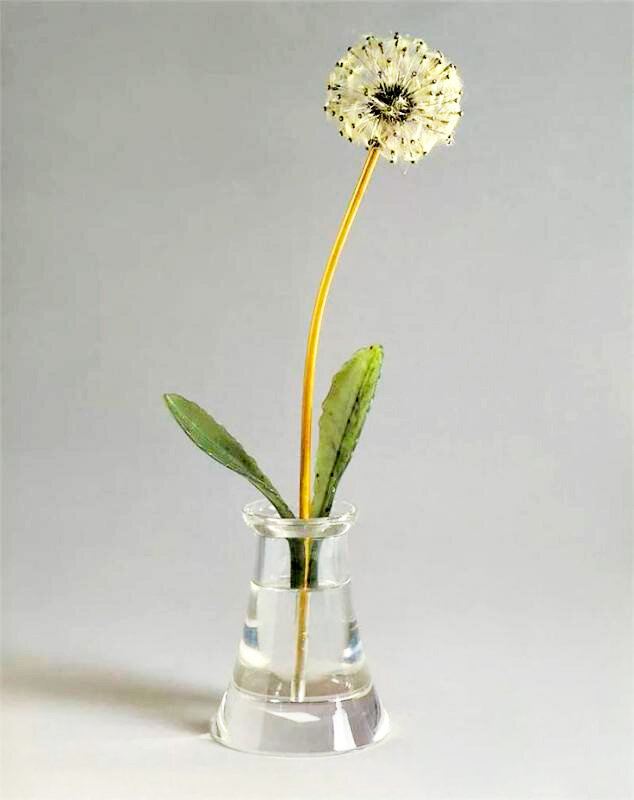
Tatyana Muntyan, curator of the Faberge collection at the Moscow Kremlin Museums, says:
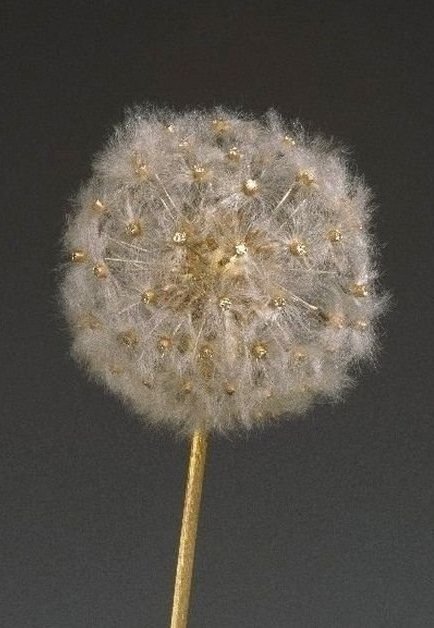
In addition to the dandelion, there are other masterpieces of jewelry art by Carl Faierge.
The idea of creating a collection was prompted by a Chinese bouquet of chrysanthemums, which were brought to Faberge for restoration. The leading master of the company, Franz Birbaum, wrote: “Thanks to the skillful selection of tones and transparency of some stones, this work made a wonderful impression” (the Chinese art of stone cutting is more than four thousand years old).
It is believed that only 80 such items have survived to this day, and the largest number of them belong to the British royal family - 26. Alexandra of Denmark, wife of the English King Edward VII and sister of Empress Maria Feodorovna, was fond of collecting precious flowers; she bought about twenty items.
In the Russian Empire, Grand Duchess Maria Pavlovna (wife of Grand Duke Vladimir Alexandrovich, the eldest uncle of Emperor Nicholas II) had the largest collection of Faberge stone flowers - about 33 items.
A team of skilled artists and jewelers worked on the creation of each flower. Everything was thought out by the craftsmen down to the smallest detail - fastening, assembly, material. The stems of plants were made of gold, their leaves were made of jade, pearls and diamonds, agate and jasper, carnelian, chalcedony and, of course, Ural gems were used for flowers. The effect of a vase with water was created by rock crystal, and thanks to a special technology, the illusion was created that the flowers were standing in real water (refraction effect).
"Pansy" is the only flower with a surprise. The flower was made in 1904 and presented by Nicholas II to Empress Alexandra Feodorovna on the tenth anniversary of their marriage. When you press the button, the flower's petals open and miniature portraits of the children of the imperial couple appear. The flower was made in the workshop of Henrik Emmanuel Wigström.
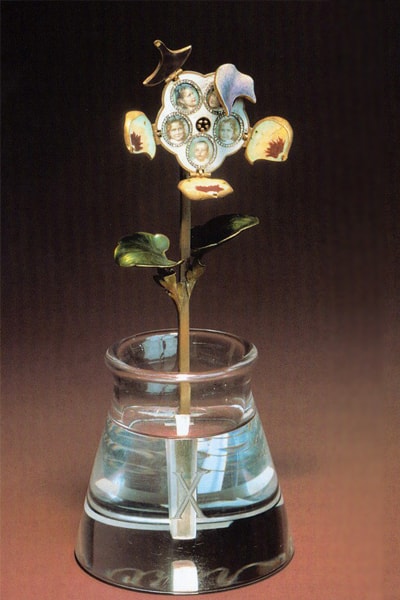
"Cornflowers and Stalks of Oats" was purchased in 1944 by Britain's Queen Mary for Queen Elizabeth.
There is a legend in Rus' about cornflowers. Once the sky reproached the cornfield for ingratitude, because everyone thanked the sky: the birds - with singing, the forests - with whispers, the flowers - with fragrance. “I fill your roots with water and thanks to me all the grains ripen, and you remain silent in response,” said the sky. “All I can do is turn from green to gold, and this is my gratitude. But I can’t reach you,” Niva answered. “Okay,” the sky agreed, “then I’ll come down to you.” Instantly, flowers grew among the ears of corn. These were soft blue or blue cornflowers, and now, when the breeze blew, the ears bowed to the flowers and whispered words of love and gratitude to them.
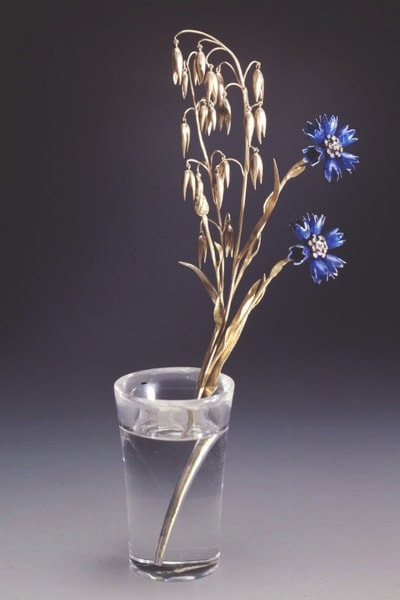
Lilies of the valley are the favorite flowers of Empress Alexandra Feodorovna. These "Lilies of the Valley" were made in the early years of the 20th century. Belongs to the British Royal Family.
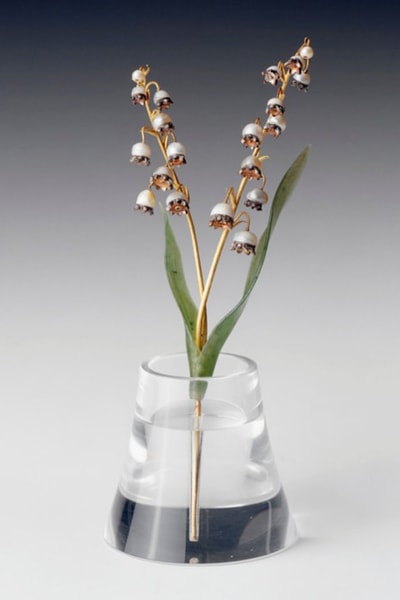
“Basket of Lilies of the Valley” - Gold, silver, jade, pearls, diamonds. Master August Wilhelm Holmström 1896
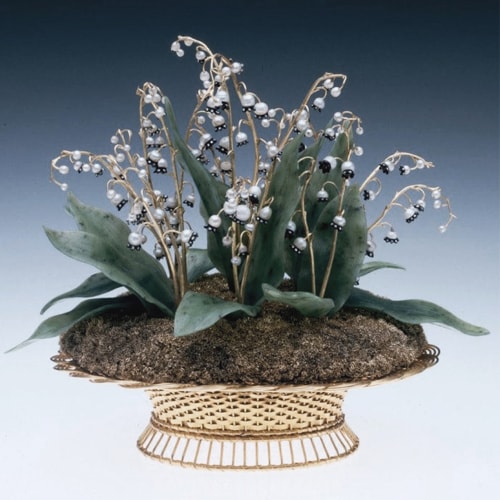
That's all for now. Thank you. I hope I was able to make you feel good.
This masterpiece by the famous jeweler became widely known only in 1994. Carl Faberge created a real miracle: natural dandelion fluff is attached to silver stamens. And on top of the fluff are scattered miniature diamonds that, under the right lighting, sparkle like morning dew. The dandelion leaves are carved from hard but fragile Siberian jade, and the stem is made of gold.

Tatyana Muntyan, curator of the Faberge collection at the Moscow Kremlin Museums, says:
“At the beginning of perestroika, the antique market was not developed. People did not have access to auctions. And so an elderly poor woman - the heiress of a famous Russian and Soviet scientist - decided to sell her relic to us. So that she would have something to live on, but, most importantly, that the masterpiece would end up in state property.
We knew that Faberge made such a flower from the memoirs of the company’s senior master, Franz Bierbaum. He wrote that natural fluff was strengthened on precious hairs with the help of small diamonds, which shone among the white fluff and distanced the artificial flower from imitating nature too closely.
We couldn’t believe that such a miracle could happen in reality until the old lady showed us a dandelion. When she took it out of the antique, original box, I immediately saw that it was genuine. Although the flowers were practically not branded due to their fragility. And here on the case it was written “Petrograd”. Which meant: the dandelion was made at the beginning of the First World War. These are the latest Faberge items and the most unique.
And a dandelion specialist from the Academy of Sciences, looking through a microscope, confirmed that we have no doubt that the product uses Asteraceae fluff. Some jewelers tried to imitate Faberge's dandelions, but it didn't work out. That’s why their flowers contain asbestos fluff.”

In addition to the dandelion, there are other masterpieces of jewelry art by Carl Faierge.
The idea of creating a collection was prompted by a Chinese bouquet of chrysanthemums, which were brought to Faberge for restoration. The leading master of the company, Franz Birbaum, wrote: “Thanks to the skillful selection of tones and transparency of some stones, this work made a wonderful impression” (the Chinese art of stone cutting is more than four thousand years old).
It is believed that only 80 such items have survived to this day, and the largest number of them belong to the British royal family - 26. Alexandra of Denmark, wife of the English King Edward VII and sister of Empress Maria Feodorovna, was fond of collecting precious flowers; she bought about twenty items.
In the Russian Empire, Grand Duchess Maria Pavlovna (wife of Grand Duke Vladimir Alexandrovich, the eldest uncle of Emperor Nicholas II) had the largest collection of Faberge stone flowers - about 33 items.
A team of skilled artists and jewelers worked on the creation of each flower. Everything was thought out by the craftsmen down to the smallest detail - fastening, assembly, material. The stems of plants were made of gold, their leaves were made of jade, pearls and diamonds, agate and jasper, carnelian, chalcedony and, of course, Ural gems were used for flowers. The effect of a vase with water was created by rock crystal, and thanks to a special technology, the illusion was created that the flowers were standing in real water (refraction effect).
"Pansy" is the only flower with a surprise. The flower was made in 1904 and presented by Nicholas II to Empress Alexandra Feodorovna on the tenth anniversary of their marriage. When you press the button, the flower's petals open and miniature portraits of the children of the imperial couple appear. The flower was made in the workshop of Henrik Emmanuel Wigström.

"Cornflowers and Stalks of Oats" was purchased in 1944 by Britain's Queen Mary for Queen Elizabeth.
There is a legend in Rus' about cornflowers. Once the sky reproached the cornfield for ingratitude, because everyone thanked the sky: the birds - with singing, the forests - with whispers, the flowers - with fragrance. “I fill your roots with water and thanks to me all the grains ripen, and you remain silent in response,” said the sky. “All I can do is turn from green to gold, and this is my gratitude. But I can’t reach you,” Niva answered. “Okay,” the sky agreed, “then I’ll come down to you.” Instantly, flowers grew among the ears of corn. These were soft blue or blue cornflowers, and now, when the breeze blew, the ears bowed to the flowers and whispered words of love and gratitude to them.

Lilies of the valley are the favorite flowers of Empress Alexandra Feodorovna. These "Lilies of the Valley" were made in the early years of the 20th century. Belongs to the British Royal Family.

“Basket of Lilies of the Valley” - Gold, silver, jade, pearls, diamonds. Master August Wilhelm Holmström 1896

That's all for now. Thank you. I hope I was able to make you feel good.
a reply to: RussianTroll
I have never seen these before. I utterly love them. That dandelion is incredible - how do they need to keep it clean?
Beautiful. Thanks for introducing me to those.
I have never seen these before. I utterly love them. That dandelion is incredible - how do they need to keep it clean?
Beautiful. Thanks for introducing me to those.
new topics
-
Israeli Officials Believe International Court Is Preparing Arrest Warrants Over War
Middle East Issues: 33 minutes ago -
Fani Willis a No Show at Democrat DA Opponent Debates
US Political Madness: 1 hours ago -
German city in chaos as 'extremist' march sees calls for 'caliphate' and ISIS-style flags
Mainstream News: 3 hours ago -
College protesters want amnesty.
US Political Madness: 4 hours ago -
Shocking moment four men 'try to force Jewish pedestrian into car boot' in North London
Breaking Alternative News: 8 hours ago -
The 'Censorship-Industrial Complex'. It is coming to a nation state near you, any time now...
New World Order: 8 hours ago
7
